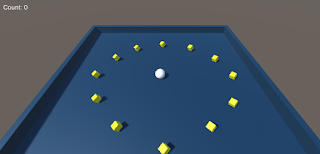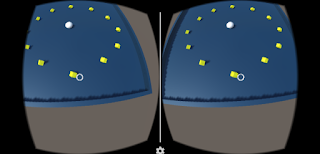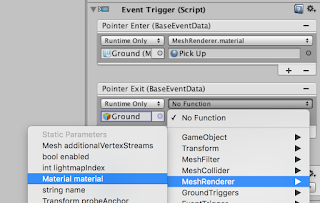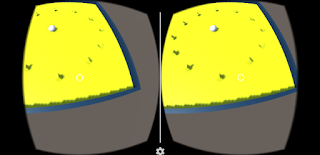Update 23-May: Note that the Cardboard SDK has now been replaced with the GoogleVR SDK. In most cases you can simply replace Cardboard with GoogleVR or GVR in the text below. There may be some steps below that are no longer needed, (e.g. some of the XCode steps are already done for you, like disabling Bitcode and including security.framework.)
I
posted on this subject before, but back then Google didn't officially support iOS with their Cardboard SDK.
That has changed, so things are a little easier now. Yesterday I decided to try it out and figured I'd share what I learned.
What I'm going to cover:
- I'll point to a simple tutorial to build a quick 3D game. We'll be extending this a little too.
- From there we'll convert that game to support VR mode using Cardboard.
- We'll add the VR camera.
- We'll add some interaction to the scene using gaze and clicks.
- We'll add some UI, including HUD and 3D buttons.
- We'll add support to switch between regular and VR modes.
- Finally, we'll build through XCode to get it running on an iPhone.
- You could do these steps earlier to try things out on your phone at each stage, but I just used the built-in Unity player in the IDE most of the time since it takes a while to build.
Prerequisites/My setup:
- I'm using the latest of everything at time of writing
- A Macbook Pro, (El Capitan,) and an iPhone 6S, (9.2.1)
- Unity 5.3.2 (Download and install this, making sure to install the iOS features.)
- Cardboard SDK v0.6 (Download this. We'll add it to our project shortly.)
- XCode 7.2.1
Getting setup and adding a VR camera
Unity offer a tutorial on their website for absolute beginners to learn about Unity fundamentals while making a very basic 3D game,
Roll-a-ball. We'll be building from this, so I highly recommend following each stage of that tutorial if you are a beginner to become familiar with the terminology, interface, game structure, etc. But if you don't want to do that,
I've uploaded the base project to GitHub, along with the final result from the tutorial below.
 |
| Roll-a-Ball |
Copy the
Roll-a-Ball project folder and name it
Roll-a-Ball VR. Open the project in Unity.
Import the Cardboard SDK: Go to
Assets >
Import Package >
Custom Package. Select the
CardboardSDKForUnity unitypackage where you
downloaded it and click
Open. Since we are using Unity 5 we can uncheck any items marked
Legacy. Notice the Cardboard and Plugins folders are added to your project.
Delete the
Main Camera item in your project hierarchy, (note that this means our
CameraController script that we wrote as part of the Unity tutorial is no longer used.) Replace your camera by dragging
Cardboard > Prefabs > CardboardMain from your project view to the scene hierarchy. Set the position of
CardboardMain to
(x,y,z)=(0,10,-10) and rotation
x=45 to get it to the same spot as our old camera. In your hierarchy select
CardboardMain > Head > Main Camera, then set
Clear Flags = Skybox in the inspector.
Press
Play, and you should see the game view showing a stereo rendering of the Roll-a-Ball board. While in play mode, press Alt and move the mouse around to pan
horizontally and vertically to simulate moving your head around. Use Ctrl to
simulate tilting your head from side to side. Your keyboard arrow keys or gamepad directional buttons will still work to move the ball around too.
 |
| Roll-a-Ball in VR! |
Adding Interaction
We're going to add the ability to interact with the game world by just looking at it. In the hierarchy select the
Event System and add a Script component
Cardboard > GazeInputModule. Make sure to move this component above any other input components in the inspector, (you can use the cog button next to the component's name.) In our case, we need to move
Gaze Input Module up once, above
Standalone Input Module. Also in the inspector, check
VR Mode Only.
Next select
CardboardMain > Head > Main Camera in the hierarchy and add a component
Event > PhysicsRayCaster, (note, make sure not to pick a
Physics 2D Ray Caster.) This will project rays from the camera into the world so we can detect collisions with the object you are looking at and react.
Now we want something to happen in response to our gaze. We'll do something simple to start with to prove things are working, switching the colour of the ground. In the hierarchy select
Ground and add an
Event > Event Trigger component. Within that component click the button to
Add New Event Type,
OnPointerEnter, and set
MeshRender.material to
Pick Up. Do the same for
OnPointerExit to have the material change back to
Background.
 |
| Setting up the Event Trigger |
Click play and try looking around. If you have part of the ground in the middle of your view you should notice it change colour. Look away and it should change back. You may notice some flicker. Lets see if we can find out why.
To make it easier to see what we are pointing at we are going to add a reticule to our view. In the project we'll drag
Cardboard > Prefabs > UI > CardboardReticule to under
CardboardMain > Head > Main Camera in the hierarchy. If you click play again you should notice a white point in the middle of the screen which changes size as it approaches objects. You should also now see that the ground doesn't change colour when we are pointing at some object in the way, (e.g. the player ball or pick ups.)
 |
| Look at the ground to change the colour |
Now let's remove that Event Trigger component so we can add something more useful in a moment.
UI in VR
Where did our UI go from the original tutorial? You may notice it is still displayed at the top left of the screen in the Game view, but we wouldn't see that when wearing our Cardboard device. So we need to make it part of the 3D world.
Unity have a doc explaining more about this. Select
Canvas in the hierarchy and see the
Canvas component in the inspector. Set the
Render Mode to
World Space and set
Event Camera to
Main Camera. Now in the Scene view if you just zoom out you should see a large rectangle, which is our UI canvas. We need to move it to a more reasonable/useful position. In the inspector set the
position to
(x,y,z)=(0,2,0),
size to
(128,128),
rotation to
x=90,
scale to
(x,y,z)=(0.1,0.1,1). Select
Canvas > Count Text in the hierarchy and change the
Anchor Preset from
top-left to
top-center, (hold
Shift and
Ctrl when clicking.) Change the
Paragraph Alignment to
Center. Note I've removed the
Win Text from the tutorial and just use the
Count Text to show the win message, which you can see in a script a little later in this post.
Click play and you should see the player's score hovering above the game board.
 |
| That text is diegetic UI, (in-world UI,) there at the top |
For fun, put the
Canvas object under
CardboardMain > Head in the hierarchy. If you play now you should see that the UI follows the player's gaze, like a HUD. While this is a badly positioned example, it should give you the idea if you wanted to try this again in future. For now, move the
Canvas back to the root of the scene hierarchy.
We're going to add a button and some script in order to reset the game board which pops up once the player has collected all of the pick-ups. So select the
Canvas and from the main menu click
GameObject > UI > Button. Position it somewhere appropriate within the canvas, (I went for a bottom-center anchor preset.) Name this button
Play Again Button and set a
Highlighted colour. Now click to disable it, (top-left checkbox of the inspector.)
On the
Canvas object we'll add a
New Script component in C#. Call it
GameplayMenu. Very simply, we just need one function here:
// Reset the game and start again
public void PlayAgain () {
UnityEngine.SceneManagement.SceneManager.LoadScene ("MiniGame");
}
Save the file and go back to Unity. Select the
Play Again Button, set the
OnClick event to use the
Canvas object and choose the
GameplayMenu.PlayAgain() action. If you have an issue finding that method, try clicking elsewhere in the editor and in the main menu click
Assets > Open C# Project and try again.
Finally we'll update the
PlayerController win code to show the button:
// Reference to a UI element so the player can reset the game
public Button playAgainButton;
void SetCountText() {
if (count == 0) {
countText.text = "Tap ground to move";
} else if (count == 12) {
countText.text = "You Win!";
playAgainButton.gameObject.SetActive (true); // Add this line
} else {
countText.text = "Count: " + count.ToString ();
}
}
Be sure to go back to the inspector for the
Player object and set the
Play Again Button setting to point to the
Play Again Button object.
Try playing the app again, collect the pick-ups and see the Play Again Button appear. Try looking at it to see the colour change, then tap it to reset the level.
Note, when I did this I noticed the world would go dark when testing within the Unity editor. To work around this you can click
Window > Lighting on the main menu, then in the
Lighting dialog box uncheck
Other Settings > Auto, then click
Build.
Bonus Interaction
We're going to make it so that you can control the game using only the Cardboard device. You'll be able to gaze at a point on the ground, click the button on your Cardboard device and the ball will move towards it. In the
PlayerController script:
// Position that could be passed in from Gaze, Touch, Mouse to move the player towards
private Vector3 moveTowardsPosition;
// Only move after a player clicks/taps, not each frame
private bool shouldMove;
// Called on first frame this script is active, (i.e. first frame of game)
void Start() {
rb = GetComponent();
count = 0;
SetCountText ();
shouldMove = false;
}
// Happens just before Physics calculations
void FixedUpdate() {
// If we got input from clicks, taps or cardboard, move towards it. Otherwise, see if there is keyboard/gamepad input.
if (shouldMove) {
// Get a vector from the player position to the point passed in
Vector3 movement = moveTowardsPosition - gameObject.transform.position;
// Multiply the input vector by the object's speed, then apply that result as a force to the object to move it
rb.AddForce (movement * speed);
// Don't do this every frame, only when we've been sent a new position, (e.g. OnClick)
shouldMove = false;
} else {
// Get device independent input, e.g. keyboard keys
float moveHorizontal = Input.GetAxis ("Horizontal");
float moveVertical = Input.GetAxis ("Vertical");
// Make a vector based on that input
Vector3 movement = new Vector3 (moveHorizontal, 0, moveVertical);
// Multiply the input vector by the object's speed, then apply that result as a force to the object to move it
rb.AddForce (movement * speed);
}
}
public void SetMoveTowardsPoint(Vector3 worldPosition) {
moveTowardsPosition = worldPosition;
shouldMove = true;
}
Select the
Ground object and add a
New Script component called
GroundTriggers. Add this code, which will forward the intersect point of the viewer's ray with the ground plane each time the player clicks their Cardboard device's button.:
public class GroundTriggers : MonoBehaviour, IPointerClickHandler {
public PlayerController player;
// Will work for clicks and Cardboard trigger presses
public void OnPointerClick(PointerEventData eventData)
{
player.SetMoveTowardsPoint (eventData.pointerCurrentRaycast.worldPosition);
}
}
Be sure to set the
Player object in the
Ground inspector, then try playing again. Look around, point and the ground and press your Cardboard button. To simulate the button press in the Unity editor you can use a mouse click. Note you may want to turn off
Raycast Target as an option on the
Count Text object so that your rays still reach the ground behind that floating text.
Awesome, we have a complete VR game for Google Cardboard!
Toggle VR mode on/off
But not everyone has a Cardboard device, so what if they still want to play our great game without us having to release a separate version from the original tutorial? Well why not have an option to toggle VR on and off?
Add another
GameObject > UI > Canvas to the root of our hierarchy. Name it
Canvas - Settings so we can differentiate from our other Canvas object more easily, (perhaps name that
Canvas - Gameboard.) Set
position (x,y,z)=(0,0,16),
size (128,128),
rotation (x,y,z)=(0,0,0) and
scale (x,y,z)=(0.1,0.1,1). Add a
New Script component called CardboardModeManager and add this code:
using UnityEngine;
using System.Collections;
using UnityEngine.EventSystems;
using System.Collections.Generic;
using UnityEngine.UI;
public class CardboardModeManager : MonoBehaviour {
// We need a reference to camera which
// is how we get to the cardboard components.
public GameObject cardboardMain;
// This is to enable/disable the reticule
private CardboardReticle cardboardReticle;
public void Start()
{
// Save a flag in the local player preferences to initialize VR mode
// This way when the app is restarted, it is in the mode that was last used.
int doVR = PlayerPrefs.GetInt("VREnabled");
Cardboard.SDK.VRModeEnabled = doVR == 1;
CardboardHead head = cardboardMain.GetComponentInChildren();
head.enabled = Cardboard.SDK.VRModeEnabled;
cardboardReticle = cardboardMain.GetComponentInChildren();
cardboardReticle.gameObject.SetActive(Cardboard.SDK.VRModeEnabled);
Cardboard.SDK.TapIsTrigger = true;
}
// The event handler to call to toggle Cardboard mode.
public void ChangeCardboardMode()
{
CardboardHead head = cardboardMain.GetComponentInChildren();
if (Cardboard.SDK.VRModeEnabled) {
// disabling. rotate back to the original rotation.
head.transform.localRotation = Quaternion.identity;
}
Cardboard.SDK.VRModeEnabled = !Cardboard.SDK.VRModeEnabled;
head.enabled = Cardboard.SDK.VRModeEnabled;
cardboardReticle.gameObject.SetActive(Cardboard.SDK.VRModeEnabled);
PlayerPrefs.SetInt("VREnabled", Cardboard.SDK.VRModeEnabled?1:0);
PlayerPrefs.Save();
}
// The Cardboard SDK can show a back button, (escaspe key
// on keyboard,) which we will use to get out of VR view
void Update () {
if (Cardboard.SDK.BackButtonPressed) {
ChangeCardboardMode();
}
}
}
Make sure you set the
CardboardMain value in the new
Canvas object's inspector.
Finally, under the
Canvas - Settings object add a
Button named
Toggle VR. Set a
highlight colour, set the label
text and set the
OnClick event to point to the
Canvas - Setting object and use
CardboardModeManager.ChangeCardboardMode() as the event.
That's it! Try playing again and switching VR mode on/off.
 |
| Our Diegetic UI Button |
Building for iOS and playing on your iPhone
From Unity we need to create an XCode project:
- Open up the Build Settings by going to File > Build Settings.
- Select iOS under Platform. After selecting iOS, click the
Switch Platform button.
- Click Player Settings to open the PlayerSettings panel in the Inspector.
- In PlayerSettings, at the bottom under Settings for iOS,
click Resolution and Presentation to expand that panel, and set the
Default Orientation to Landscape Left.
- Click Other Settings to expand that panel and find the Bundle
Identifier field. Enter a valid package name for your application (such as
com.mycompany.cardboarddemo)
- Click Build. This prompts you for a save name, and prepares an XCode project
in the [your Unity project]/[your save name] directory.
From XCode we will build the app and put it on your iPhone:
- Open XCode. From the File > Open... menu, open the XCode project that
you created. It will be a file called
Unity-iPhone.xcodeproj inside the
directory you just saved under in the last section.
- Select the Unity-iPhone project by clicking on it.
- In the project menu bar, click on Build Phases to open that section.
- Expand the Link Binary With Libraries list.
- At the very bottom of the Link Binary With Libraries list, click the + sign.
This opens a window that says "Choose frameworks and libraries to add:".
- Type
Security into the search box. When Security.framework appears, double-click on it to add it to the libraries.
- Disable Bitcode by setting Build Settings > Build Options > Enable BitCode to No.
- Now run the project, either by clicking the play button, or by going to
Product > Run.
If all went well, you should see a "Build Succeeded" and your game launches
on your iPhone!
Hope that helped someone!
Ash















